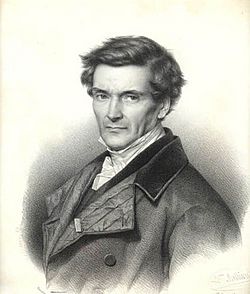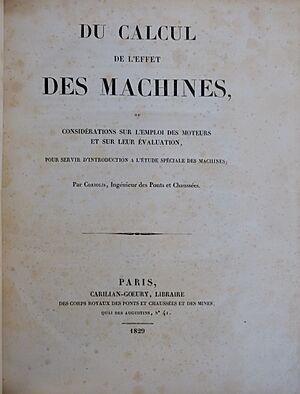Gaspard-Gustave de Coriolis facts for kids
Quick facts for kids
Gaspard-Gustave de Coriolis
|
|
|---|---|

Gaspard-Gustave de Coriolis
|
|
| Born | 21 May 1792 Paris, France
|
| Died | September 19, 1843 (aged 51) Paris, France
|
| Nationality | French |
| Alma mater | École Polytechnique |
| Known for | Coriolis effect Differential analyser Integraph Kinetic energy |
| Scientific career | |
| Fields | Mathematics, Physics |
| Institutions | École Centrale Paris École Nationale des Ponts et Chaussées École Polytechnique |
Gaspard-Gustave de Coriolis (born May 21, 1792 – died September 19, 1843) was a smart French scientist. He was a mathematician and an engineer. He is famous for explaining something called the Coriolis effect. This effect helps us understand how things move on a spinning object, like Earth! He also helped define the idea of "work" in science. Work is about how energy is moved when a force pushes something over a distance.
Contents
About Gaspard-Gustave de Coriolis
Coriolis was born in Paris, France, in 1792. He was a very bright student from a young age. In 1808, he took an important entrance exam. He placed second among all the students trying to get into the school that year.
Early Career and Studies
In 1816, Coriolis became a tutor at the École Polytechnique. This was a famous school in France. There, he did many experiments. He studied friction, which is the force that slows things down when they rub together. He also studied hydraulics, which is about how liquids move and flow.
Important Discoveries and Books
In 1829, Coriolis wrote a textbook. It was called Calcul de l'Effet des Machines, which means "Calculation of the Effect of Machines." This book explained how machines work in a way that was useful for industries. Around this time, scientists figured out the correct way to describe kinetic energy. Kinetic energy is the energy an object has because it is moving. The formula for it is ½mv2. This book also showed how kinetic energy relates to mechanical work.
Over the next few years, Coriolis continued his research. He wanted to understand kinetic energy and work even better. He focused on how these ideas applied to things that were spinning or rotating.
The Coriolis Effect
One of his most famous papers was published in 1835. It was called Sur les équations du mouvement relatif des systèmes de corps. This means "On the equations of relative motion of a system of bodies." In this paper, Coriolis talked about special forces that appear when you are on a rotating object. He divided these forces into two types. One of these types eventually became known as the Coriolis force.
It's interesting to know that Coriolis's work didn't directly talk about the Earth's atmosphere. He also didn't talk about the Earth's rotation. Instead, he focused on how energy moves in spinning systems, like waterwheels. His ideas were later used by other scientists to understand weather patterns and ocean currents. This is why his name is now strongly linked to meteorology, the study of weather.
Other Works and Achievements
In 1835, Coriolis also published a math book about how spheres collide. It was called Théorie Mathématique des Effets du Jeu de Billard. This book is still considered a classic for understanding how billiard balls bounce off each other.
Coriolis became a professor of mechanics in 1829. He taught at the École Centrale des Arts et Manufactures. Later, in 1836, he took over a special position at the École Nationale des Ponts et Chaussées. He also joined the Académie des Sciences, a very important group of scientists. In 1838, he became the director of studies at the École Polytechnique.
Legacy and Recognition
Gaspard-Gustave de Coriolis passed away in 1843 in Paris. He was 51 years old. His important work in science is still remembered today. His name is even one of the 72 names written on the Eiffel Tower in Paris. This shows how much he contributed to science and engineering.
See also
 In Spanish: Gaspard Coriolis para niños
In Spanish: Gaspard Coriolis para niños
Images for kids





